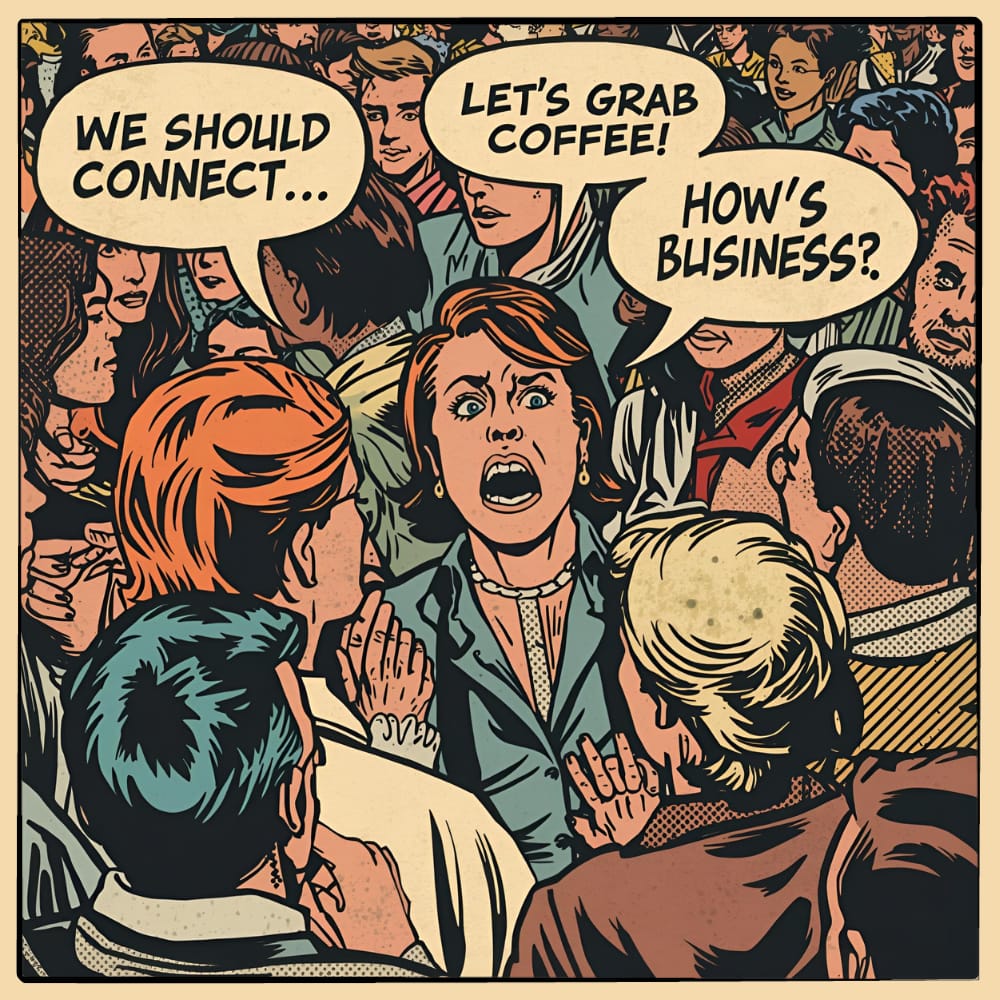- Be More Relatable
- Posts
- Stop trying to meet everyone at events
Stop trying to meet everyone at events
Why going deep beats going wide every single time
I write weekly about the strategies, habits, and tactics around cultivating the connections that matter to you.
I walk into an event and immediately my brain starts doing mental tetris.
"There's Michael. Oh, and Katherine is here too. Wait, is that the person I met at the last event? I should definitely say hi. And I really need to catch up with Jennifer. Plus I’ve been wanting to meet…"
By the time I'm done mentally inventory-ing the room, I'm overwhelmed and the event hasn't even started.
Given how socially awkward I am, you'd probably assume I'd want to avoid as many people as possible. And you'd be half right. Earlier in my career, I used to show up to events with one goal: do a quick lap around the room, check the box, and get home before most people would refresh their drink.
But here's the weird part. Despite my awkwardness, I've always had this conflicting desire to connect with everyone. To not miss anyone. To not leave anyone out, or feel left out of any connection.
Spoiler: that was a disaster.

What actually happens when you try to meet everyone
Here's what I've learned after coaching thousands of professionals on relationship-building: trying to connect with everyone at an event is a recipe for disappointment. You'll end up having a bunch of "Hey, how are you?" conversations that leave everyone feeling like they just participated in professional small talk Olympics.
And what do superficial conversations create? Superficial relationships.
The T-shaped approach
Think of your event strategy like the letter T.
The horizontal bar represents quick hellos to lots of people. The vertical bar represents going deep with one or two. Most people spend all their time on the horizontal, thinking more connections equals better networks. Errrrp.
I have zero problem giving someone I know a genuine hug, saying "so good to see you, let's catch up properly soon", and moving on. That's not being rude. That's being honest about the fact that meaningful conversation in a crowded room between passed appetizers isn't actually possible.
The magic happens when you identify one or two people you genuinely want to spend time with and you actually do it. Real conversation. Real questions. Real attention.
Yes, this means accepting FOMO. Yes, you might feel guilty walking past people. Yes, you might worry you're being rude. But likely, they're doing the same mental math you are, and a quick genuine hello beats a forced three-minute-and-move-on conversation neither of you will remember.
Making it work
Before the event: Look at the attendee list. Pick 1-2 people you actually want to have real conversations with. Not the most important people. Not the people you think you should talk to. The people you're genuinely curious about.
During the event: Give yourself permission to be selectively social. Quick hellos are fine. Great, even. But protect your energy for the deeper conversations. Find a quieter corner. Grab coffee away from the crowd. Take a walk outside if the venue allows it.
After the event: Here's the part most people miss. That attendee list? It's your outreach list. Seeing someone at an event gives you the perfect excuse to follow up later: "Great seeing you at the conference last week. Would love to actually catch up properly".
You just transformed a room full of missed connections into a pipeline of potential meaningful conversations. And you can have those conversations in settings where you're more comfortable, on your terms, where real relationship-building can actually happen.
Why this actually works
Depth beats breadth in relationship-building. Always has, always will.
When you try to talk to everyone, you're splitting your attention 50 different ways. Nobody gets the real you. Nobody walks away thinking "wow, that was a great conversation". They walk away thinking "oh yeah, I think I met that person".
When you focus on one or two real conversations, something shifts. You're present. You're engaged. You ask better questions. You share more authentically. The other person feels it. That's the conversation they remember. That's the connection that turns into something.
Plus, it's just more sustainable. If you're like me and networking events drain your battery faster than a phone with 50 apps running, the T-shaped approach lets you show up without burning out. You still make an appearance. You still see people.
But you're not trying to be everything to everyone. If you are (as I have in the past)… g’luck!
Until next week, Zvi
P.S. Networking burnout is real. Hydrate responsibly.
Feedback is a gift! What did you think this week? |
Ever notice how the people who connect most easily aren’t the ones who talk the most, but the ones who open up first? In this video, we’ll dive into how leading with vulnerability can completely change the way people respond to you — at work and in life.
Topics we cover:
Why sharing small imperfections actually makes people trust you more
The science behind vulnerability and reciprocity (and how it works in real conversations)
How to be open without oversharing or seeming unprofessional
Four simple ways to use “strategic vulnerability” in meetings and messages
Real-world examples of how going first builds deeper, faster connections
You can see all my videos and interviews on my channel! If you find these helpful, I’d appreciate a like, subscribe, and share with a friend, colleague, or enemy.